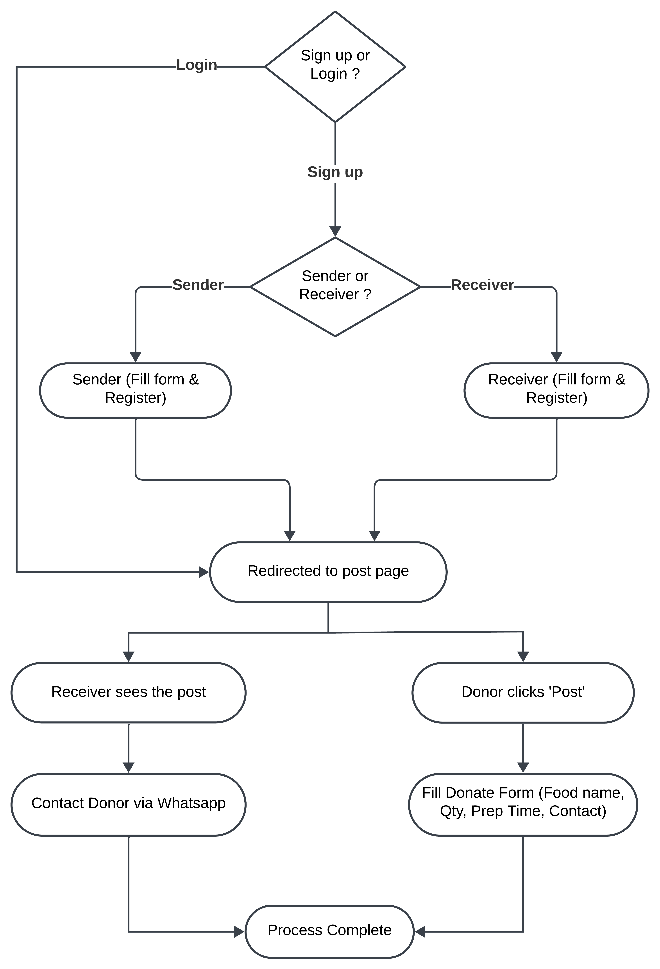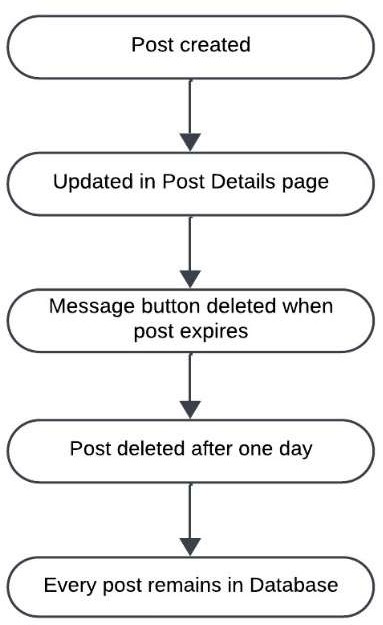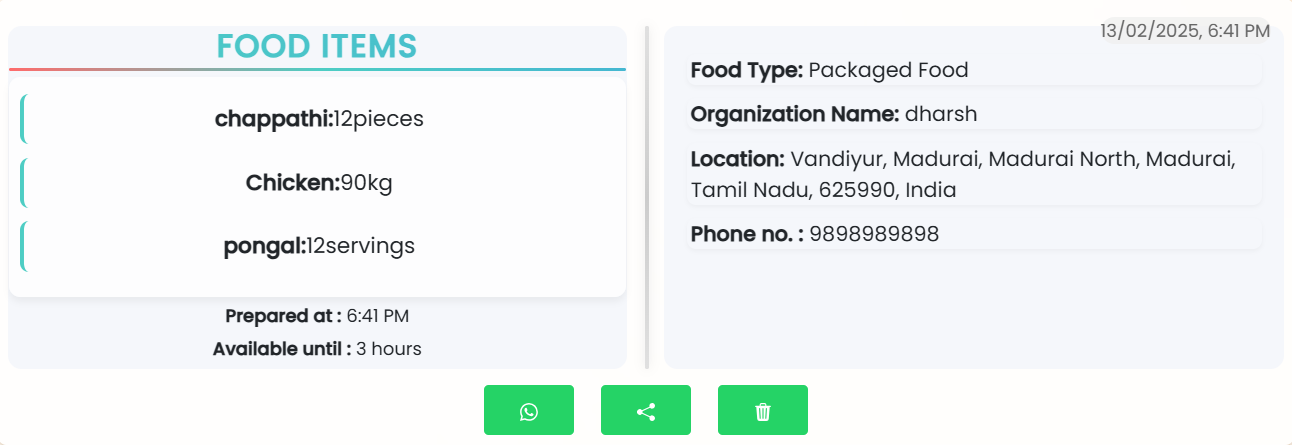Ijraset Journal For Research in Applied Science and Engineering Technology
- Home / Ijraset
- On This Page
- Abstract
- Introduction
- Conclusion
- References
- Copyright
Bridging Food Surplus to Smiles through Smart Donation and Sustainable Recycling
Authors: S. A. Shobika, T. S. Dharshini, K. R. Sruthi, Dr. S. Parthasarathy, Dr. S. Miruna Joe Amali, Dr. J. S. Kanchana, R. Thangasankaran
DOI Link: https://doi.org/10.22214/ijraset.2025.66975
Certificate: View Certificate
Abstract
Food wastage represents a pervasive global challenge, with substantial volumes of consumable food being routinely discarded, juxtaposed against widespread hunger and nutritional insecurity afflicting numerous communities. This issue is particularly pronounced in contexts such as event venues, ceremonial halls, and large-scale organizations, where surplus provisions frequently remain underutilized. HungerTreat endeavors to address this dichotomy by establishing a sophisticated platform that facilitates the redistribution of excess food to orphanages, old age homes and similar institutions, while concurrently enabling the conversion of residual waste into nutrient- rich fertilizer via biomass recycling systems. By amalgamating optimized food reallocation mechanisms with sustainable waste management practices, the platform aspires to mitigate food wastage and foster environmental stewardship. This paper elucidates the technical underpinnings of HungerTreat, emphasizing its architectural framework, including the integration of Firebase for robust data security, meticulous data management, and the intricacies of its recycling protocol. Furthermore, the discourse extends to delineate the challenges encountered during development and the potential trajectories for augmenting the system\'s scalability and societal impact.
Introduction
I. INTRODUCTION
Food wastage poses a critical global challenge, with significant amounts of edible food being discarded annually despite pervasive hunger and malnutrition. According to the United Nations Food and Agriculture Organization (FAO), nearly one-third of food produced for human consumption is wasted, reflecting a stark imbalance in resource allocation [6,8]. This issue becomes more pronounced in large-scale events such as weddings and social gatherings, where surplus food often remains underutilized [1,2]. Beyond exacerbating food insecurity, this wastage contributes to environmental degradation through resource inefficiencies and increased emissions [9].
Efforts to address these challenges have led to the development of innovative solutions such as HungerTreat, which employs technology to bridge surplus food sources with underserved communities [3,7]. Platforms leveraging web-based technology have proven effective in facilitating resource redistribution while minimizing waste [5,7]. Additionally, solutions incorporating sustainable practices, like converting inedible food into organic fertilizer, emphasize the potential for circular economy models to mitigate environmental impact [6,10]. This paper explores the technological underpinnings and societal implications of such systems, focusing on their role in fostering food security and sustainability.
II. METHODOLOGY
The HungerTreat platform leverages a robust and meticulously designed technological stack to deliver an efficient, scalable, and user-centric solution addressing food redistribution and sustainability challenges. The frontend is crafted using React.js, enhanced by CSS and Bootstrap to ensure responsive and aesthetically cohesive designs across devices, while TypeScript introduces static typing for improved code reliability and maintainability. The integration of smooth animations not only enriches the visual appeal but also augments the platform’s overall interactivity, ensuring an engaging user experience.
The backend is powered by Node.js and Express.js, which facilitate seamless API communication between the client and server, enabling efficient request handling and robust data processing. This architecture ensures high performance under varying loads and provides a scalable foundation for future enhancements.
MongoDB, as the database layer, plays a pivotal role in securely storing critical data, including donor profiles, recipient details, hashed authentication credentials, and comprehensive records of donation posts. Its schema flexibility and reliability ensure that data retrieval and updates are efficient and consistent with the platform’s needs.

Fig: 1 Flow diagram
Firebase integration is employed for user authentication, offering a secure, scalable, and reliable solution for managing login, registration, and session persistence. This eliminates vulnerabilities while simplifying the implementation of authentication workflows. Furthermore, to streamline real-time communication, HungerTreat integrates WhatsApp, bypassing the need for a complex, custom-built messaging system. This integration ensures donors and recipients can instantly connect, fostering prompt coordination and timely food redistribution.
Many existing platforms rely on mobile apps, complex workflows, and non-intuitive communication mechanisms. HungerTreat fills this gap by integrating a web-based system (using the MERN stack) with simple, effective communication through WhatsApp, making it accessible and user- friendly. By combining these advanced technologies, HungerTreat not only addresses the logistical challenges of surplus food redistribution but also adheres to industry best practices in software engineering. The platform’s scalable and modular architecture positions it as a forward-thinking solution, capable of evolving with future technological advancements and increasing societal impact.
III. SEAMLESS WORKFLOW FOR FOOD DONATION AND REDISTRIBUTION
The system facilitates a streamlined workflow, detailing how donors and receivers interact with the platform to manage food donations from initiation to completion. Users begin by registering via Firebase’s secure authentication system, selecting their role as either a donor or a receiver during the signup process.
For donors, the process begins with redirection to the Post Page after registration, where they can create a donation post by clicking the "Post" button. The donation form requires key details such as the food name, quantity, preparation time, and a contact number for receivers to connect. Once submitted, the post becomes visible on the platform for potential receivers.
Receivers, upon registration, are similarly redirected to the Post Page, where they can browse available food donation posts. If a post aligns with their needs, receivers can use the integrated WhatsApp button to directly contact the donor and coordinate the collection of the food.
This user-centric workflow, enhanced by Firebase authentication and WhatsApp integration, ensures a simple, intuitive, and effective mechanism for addressing food redistribution challenges.
IV. AUTOMATED QUALITY ASSURANCE FOR SAFE FOOD REDISTRIBUTION
Ensuring the relevance and safety of food donations is a cornerstone of the HungerTreat platform, achieved through an automated validation mechanism governed by the food's preparation time. Donors are mandated to provide the precise preparation time during the posting process, which serves as the primary determinant for assessing freshness and safety. The platform employs real-time tracking to monitor the elapsed time since the post's creation. To uphold quality standards, posts are subjected to a stringent expiration protocol. Within 24 hours of the stated preparation time, the post is automatically marked as unavailable, disabling interactive features such as the WhatsApp contact button to prevent any further engagements between donors and receivers. This ensures that potentially unsafe food does not circulate through the system.
Furthermore, to maintain the integrity of the platform, the system enforces post deletion 48 hours after the stated preparation time. This dual-layered process of disabling and subsequent removal that only fresh, consumable food remains accessible, aligning with HungerTreat’s commitment to food safety and reliability in addressing surplus food redistribution.

Fig: 2 Process flow
V. "DONATED FOOD!" PROMINENTLY DISPLAYED TO HIGHLIGHT THE PURPOSE OF THE PAGE.

Figure: 3 Donated Food
The HungerTreat post page exemplifies an efficient and visually engaging platform for facilitating surplus food donations. Each post card meticulously details critical information, including the food type, quantity, preparation time, donor organization, location, and contact number, ensuring seamless communication and coordination. Active posts are distinctly highlighted with actionable elements like a "Message" button, while unavailable posts are flagged with bold red text to indicate their claimed status. The vibrant food-themed background reinforces the platform's mission, while the structured design ensures clarity and accessibility. This dynamic interface underscores HungerTreat's commitment to streamlining the donation process and maximizing the redistribution of surplus food to aadharavatror illams and other beneficiaries.
VI. DONORS STIPULATIONS AND RECEIVERS OBLIGATIONS.
Donors are singularly responsible for ensuring the gastronomic integrity and safety of food uploaded to the platform, mandating meticulous preparation documentation, comprehensive hygiene maintenance, and precise provision details. They must guarantee accurate representation of food quantity, condition, and preparation parameters, while maintaining unequivocal availability for timely food transfer and promptly updating or removing listings if food becomes unsuitable or unavailable.
Recipients bear complete responsibility for autonomous transportation logistics, collection coordination, and post-retrieval food management. They must strategically plan food collection within agreed temporal parameters, maintain transparent communication with donors regarding retrieval specifics, and assume full liability for judicious handling, secure transportation, and ultimate consumption of the procured provisions.
Conclusion
In summation, HungerTreat embodies a paradigm shift in addressing the dichotomy of food wastage and hunger through a meticulously engineered platform that operationalizes the redistribution of surplus food from institutional sources to underserved populations. This system integrates sophisticated technologies to facilitate the real-time orchestration of food donations, leveraging dynamic data pipelines for availability tracking and algorithmic efficiency in distribution logistics. Furthermore, its commitment to sustainability is exemplified by the transformation of residual food into biomass and organic fertilizers, advancing the principles of a circular bioeconomy. Notwithstanding its operational robustness, HungerTreat encounters inherent challenges such as ensuring the perishable integrity of food items during extended transit, sustaining donor-recipient synergy in non-urbanized locales, and scalability constraints. By incorporating edge computing for real-time analytics, AI-driven demand-supply prediction models, and blockchain for immutable traceability, these impediments can be systematically mitigated, enhancing the system’s efficacy. As the dual crises of global food insecurity and resource inefficiency intensify, HungerTreat emerges as a quintessential exemplar of techno-philanthropy, intertwining advanced innovation with altruistic imperatives. Its multifaceted framework not only redefines food donation mechanisms but also propagates systemic sustainability, setting a benchmark for transformative interventions in social welfare and environmental stewardship. This initiative paves the way for scalable, high-impact solutions that reimagine the nexus between technological advancement and humanitarian objectives.
References
[1] B. S, E. Mohanraj, S. M and V. P, \"Optimizing Surplus Food Management: A User-Centric Application Approach,\" 2024 Second International Conference on Emerging Trends in Information Technology and Engineering (ICETITE), Vellore, India, 2024, pp. 1-6, doi: 10.1109/ic-ETITE58242.2024.10493353. [2] Y. V S and B. M, \"IoT-Aided Charity-Redistribution of Excess Food,\" 2024 Second International Conference on Emerging Trends in Information Technology and Engineering (ICETITE), Vellore,India, 2024, pp. 1-6, doi: 10.1109/ic- ETITE58242.2024.10493783. [3] R. Kavitha, V. N. Prasad, D. Gowda V, U. M, S. K and A. K, \"A Novel Approach for Identification and Donation of Surplus Food using Machine Learning- based Replate App,\" 2023 Second International Conference on Augmented Intelligence and Sustainable Systems (ICAISS), Trichy, India, 2023, pp. 552-558, doi: 10.1109/ICAISS58487.2023.10250748. [4] S. Aruna, S. S, B. K and H. N, \"A New Mobile Application Design to Empower Local Communities through Seamless Resources Sharing,\" 2024 International Conference on Cognitive Robotics and Intelligent Systems (ICC - ROBINS), Coimbatore, India, 2024, pp. 916-920, doi: 10.1109/ICC- ROBINS60238.2024.10533894. [5] Apostolidis C, Brown D, Wijetunga D, et al. (2021) Sustainable value co-creation at the Bottom of the Pyramid: Using mobile applications to reduce food waste and improve food security. Journal of Marketing Management 37: 856–886. [6] Chaboud G, Daviron B (2017) Food losses and waste: Navigating the inconsistencies. Global Food Security 12: 1–7. [7] Corbo C, Fraticelli F (2015) The use of web-based technology as an emerging option for food waste reduction. In: San-Epifanio LE, De Renobales Scheifler M (eds) Envisioning a Future Without Food Waste and Food Poverty. Bilbao, Spain: Wageningen Academic Publishers, pp. 133–142. [8] de Almeida Oroski F, da Silva JM. Understanding food waste-reducing platforms: A mini-review. Waste Management & Research. 2023;41(4):816-827. doi:10.1177/0734242X221135248 [9] H. Hajjdiab, A. Anzer, H. A. Tabaza, and W. Ahmed, “FiCloud Workshops - A Food Wastage Reduction Mobile Application,” (6th International Conference on Future Internet of Things and Cloud Workshops- FiCloudW, 2018), pp. 152–157 [10] M. S. M. Zamzuri, B. Rahmatullah, S. Purnama, O. A. Dheyab; Development of food sharing IT platform for university community. AIP Conf. Proc. 21 March 2024; 2750 (1): 060002. https://doi.org/10.1063/5.0148929 [11] Niina Sundin a, Louise Bartek a, Christine Persson Osowski b, Ingrid Strid a, Mattias Eriksson aRecei ved 28 December 2022, Revised 19 March 2023, [12] R. Kavitha, V. N. Prasad, D. Gowda V, U. M, S. K and A. K, \"A Novel Approach for Identification and Donation of Surplus Food using Machine Learning- based Replate App,\" 2023 Second International Conference on Augmented Intelligence and Sustainable Systems (ICAISS), Trichy, India, 2023, pp. 552-558, doi: 10.1109/ICAISS58487.2023.10250748 [13] Gai Wei-wei, Zhang Shu-hai and Liu Ke-fei, \"Research on information sharing platform for seamless supervising of food safety,\" 2011 International Conference on Electric Information and Control Engineering, Wuhan, China, 2011, pp. 1635- 1638, doi: 10.1109/ICEICE.2011.5777208 [14] G. -t. An, S. Oh, E. Kim and J. -m. Park, \"Data Lake Conceptualized Web Platform for Food Research Data Collection,\" in Journal of Web Engineering, vol. 23, no. 3, pp. 377-392, May 2024, doi: 10.13052/jwe1540-9589.2333 [15] X. Hu and X. Wang, \"Research on Food and Beverage Supply Chain Based on Real-Time Information Sharing Platform,\" 2019 12th International Conference on Intelligent Computation Technology and Automation (ICICTA), Xiangtan, China, 2019, pp. 686-691,doi:10.1109/ICICTA49267.2019.00
Copyright
Copyright © 2025 S. A. Shobika, T. S. Dharshini, K. R. Sruthi, Dr. S. Parthasarathy, Dr. S. Miruna Joe Amali, Dr. J. S. Kanchana, R. Thangasankaran. This is an open access article distributed under the Creative Commons Attribution License, which permits unrestricted use, distribution, and reproduction in any medium, provided the original work is properly cited.

Download Paper
Paper Id : IJRASET66975
Publish Date : 2025-02-15
ISSN : 2321-9653
Publisher Name : IJRASET
DOI Link : Click Here
 Submit Paper Online
Submit Paper Online

